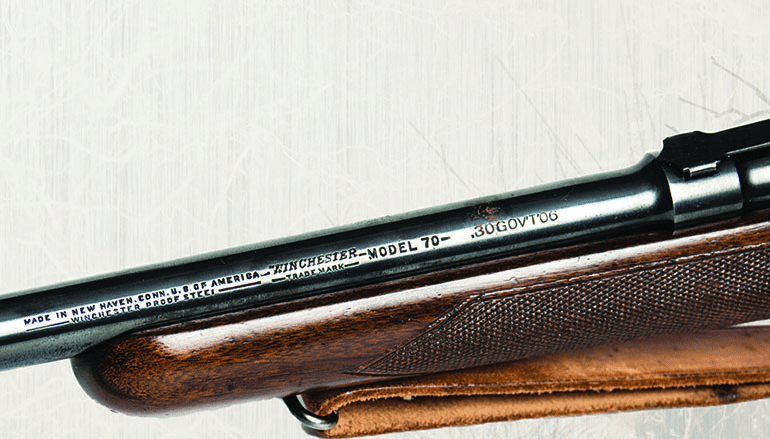
The Versatile .30-06
By Horace Gore
If there ever were a hunting rifle caliber that is “international,” it’s the venerable .30-06. This old “30” has lasted well over 100 years in the hunting world. There are several good reasons why this 30-caliber icon has lasted so long, and is still a favorite of many hunters. It has versatility for hunting a worldwide variety of game. The .30-06 has several features that make it a favorite. The recoil from most sporter rifles is tolerable, even to youthful hunters and petite ladies. A variety of factory ammunition is available at most corner stores, with bullets at velocities that will take any size and shape of North American game. This ammo is also good for most plains game of Asia and Africa. The 125-grain soft point is good on varmints such as coyotes and bobcats. The 150 is excellent for deer, pronghorns, and wild sheep. The 180-grain bullet will do well on elk, moose and South Texas nilgai. The heavy 220-grain will break down the biggest grizzly or bull moose. I may have omitted a few favorite species, but you get the message—the .30-06 is truly versatile. Even in this day of numerous rifle calibers from medium to the biggest Magnums, the age-old .30-06 still holds its own. My recent observation is it’s still one of the five most popular calibers in North America. They are, in order: .30-30; .30-06; .308; .243; and .270.
First rifle
My experience with the .30-06 is long and varied. My first legitimate deer rifle was a World War I 1917 Enfield .30-06 made by Winchester. I bought it from a friend for $40. After replacing the military wood with a $17 Bishop stock, and cutting the barrel to 23 inches behind the large front sight with a hack saw, I crowned the barrel with a hand-held 3/8-inch drill. Its sight “ears” were cut with the hacksaw and filed smooth. Regular hardware screws were used to install a Weaver side mount for a 4-power scope. The two-stage military trigger was horrible, but some technical genius using a brass welding rod and a file took all the slack out of the trigger and left a 3-pound pull. Believe it or not, after all this shade tree work on the rifle, it would shoot a three-shot group about the size of a quarter at 100 yards. I used that old .30-06 with 150-grain hand loads for several years after I graduated from Texas A&M and worked for the old Texas Game and Fish Commission at Mineral Wells and Brownwood. One reason it shot so well was its weight—about 10 pounds with sling and ammo.
Whitetail hunting
After that first .30-06 that accounted for 17 whitetails, several varmints a few feral hogs, I got a raise in pay and traded the .30-06 for a Remington Model 721 in .270. But like a lot of deer hunters and gun traders, I’d give anything to have that first .30-06 back after 55 years and many rifles. To be sure, I’ve always had a good .30-06 in my battery of rifles, and have always used the ’06 with confidence. My favorite hand load for Texas game—whitetails, pronghorn, hogs, and exotics—is a good 150-grain bullet and 54 grains of 4320 in Winchester cases. This load has killed many deer and a few pronghorns. I was always curious why it knocked all the hair off an animal about 2-3 inches around the bullet hole. I didn’t have a chronograph back in those days, but thought the velocity was about 3,000 fps in the 23-inch barrel. I killed my first good buck with this load. I was on a ranch south of Brownwood, riding with a close friend. We saw a high-antlered buck with four does out on a flat about 150 yards away. I got the nod from the landowner and immediately put a 150-grain silvertip in the buck at the point of the shoulder. He fell quicker than a one-egg pudding. We later scored him a shade less than 150 B&C, which was a good low fence buck at the time.
Nilgai hunting
My use of 180-220 grain bullets is long but thin. Since I’ve hunted mostly whitetails, pronghorns, mule deer, hogs and exotics through the years, I’ve never needed bullets heavier than 150-grain. But my friends have used the heavy bullets on elk, nilgai and such with good success. The largest head of game that I’ve taken with the .30-06 in Texas was a nilgai cow. I hunted with a friend on the Kenedy Ranch near Sarita in South Texas. The cow had eluded us for quite a while, but I finally got a shot through some thick brush, as she stood hidden at about 80 yards. The super grade Model 70 cracked, and the 180-grain bullet dropped her in her tracks. The nilgai is a rather big antelope—she weighed about 400 pounds—and a mature bull may go 500 pounds or more. Some folks say the .30-06 with 180-grain Nosler partition bullets is too light for nilgai, but I’d shoot one in a New York minute with that load. A bull that lives through that would have a halo over his head. Or be blessed by the Pope! Yes, the versatile .30-06 has survived over 100 years of competition from many popular calibers pumped up unbelievably my outdoor writers. Jack O’Connor preached on the virtues of the .270, and almost made the Winchester Model 70 in .270 calibers a household rifle for the masses. Truth is, he used the .30-06 exclusively during his early years of hunting, and went to the Winchester .270 when it became a necessary promotional commodity for his paycheck. Close friends have quoted Jack as saying, “The ’06 with good bullets is hard to beat.” That has been my experience, and obviously that of thousands of hunters in America and around the world.



